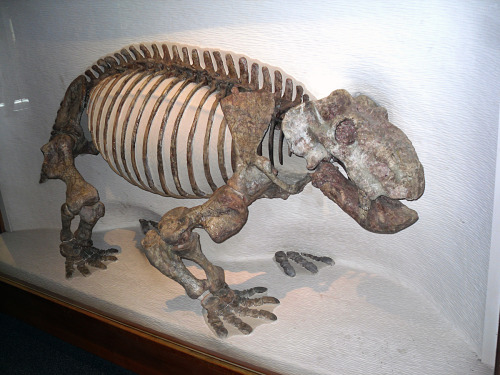Dinodontosaurus Mounted specimen on display at the Harvard Museum of Natural History Reconstruction
Dinodontosaurus Mounted specimen on display at the Harvard Museum of Natural History Reconstruction by Dmitry Bogdanov When: Triassic (242 - 230 million years ago) Where: Worldwide What: Dinodontosaurus is a synapsid, or ‘mammal like reptile’. It was one of the most common large herbivorous animals in the mid Triassic. These beasts reached lengths of 8 feet (2.4 meters) and are estimated to have weighed hundres of pounds. They fall within the clade Dicynodontia, so named for their two large front teeth. A fossil find in Brazil of over 10 Dinodontosaurus, including juveniles, shows these animals lived in herds and cared for their young. Synapsids were extremtly common in the Permian, but were hit hard by the end Permian extinction. Some groups, such as the Dicynodonts exemplified by Dinodontosaurus, however, made it though the extinction just fine. The extinction at the end of the Triassic period, however, was brutal to this clade, wiping out the vast majority of species. Some dicynodonts made it though this extinction, but the clade continued to dwindle throughout the rest of the Mesozoic, with the last dicynodont vanishing in the mid Cretaceous. In the synapsid family tree dicynodonts are fairly far up there, falling far closer to gorgonopsids than to the basal “pelycosaurs”. -- source link
Tumblr Blog : dailyfossil.tumblr.com
#triassic#south america#europe#synapsid#paleontology#geology#fossil#biology#evolution#science#mesozoic

